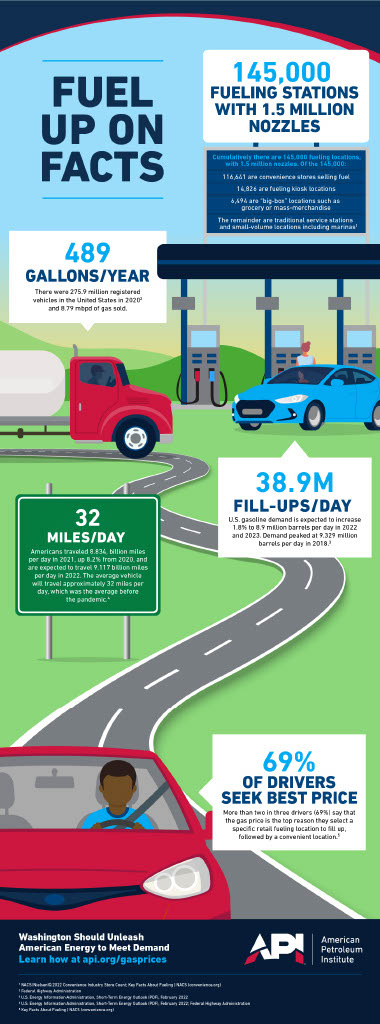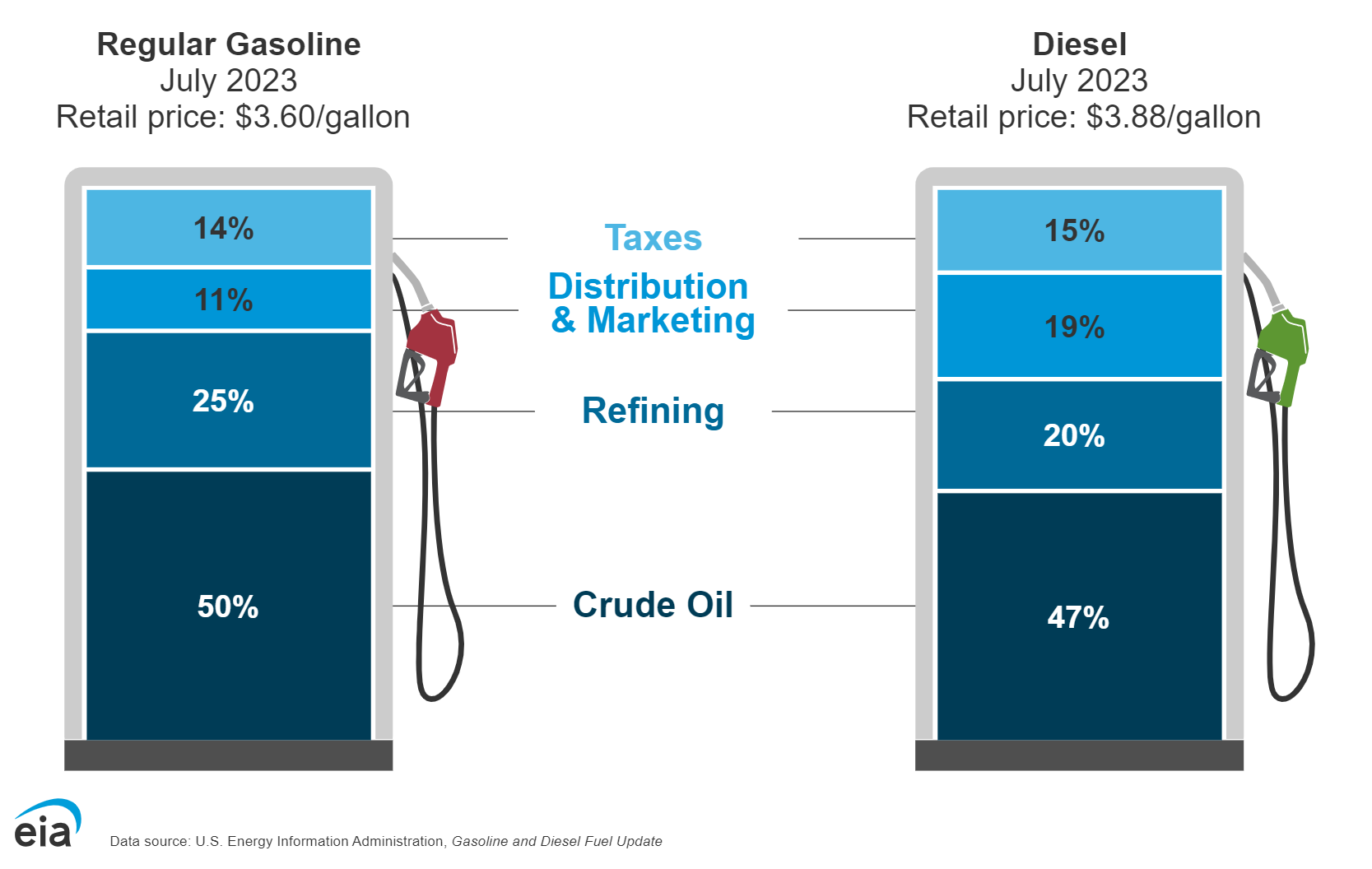Gas Prices Explained
Five Fast Facts About U.S. Gasoline Prices
- Petroleum prices are determined by market forces of supply and demand, not individual companies, and the price of crude oil is the primary determinant of the price we pay at the pump. Oil prices are at a seven-year high amid a persistent global supply crunch, workforce constraints, increasing geopolitical instability in Eastern Europe, the economic rebound following the initial stages of the pandemic, and policy uncertainty from Washington.
- Policy choices matter. American producers are working to meet rising energy demand as supply continues to lag, but policy and legal uncertainty is complicating market challenges.
- The administration needs an energy-policy reset, and Europe is a cautionary tale. We need not look further than the situation in Europe to see what happens when nations depend on energy production from foreign sources that have agendas of their own. There is more policymakers could do to ensure access to affordable, reliable energy, starting with incentivizing U.S. production and energy infrastructure and sending a clear message that America is open for energy investment.
- Repeated in-depth investigations by the FTC have shown that changes in gasoline prices are based on market factors and not due to illegal behavior, and the American people are looking for solutions, not finger pointing. The price at the pump that Americans are currently paying is a function of increased demand and lagging supply combined with the geopolitical turmoil resulting from Russia’s aggression in Ukraine.
- Lawmakers should focus on policies that increase U.S. supply to help mitigate the situation rather than political grandstanding that does nothing but discourage investment at a time when it's needed the most.

On this page:
Read also:
- Five Fast Facts About U.S. Gasoline Prices
- Earnings in Perspective
- Digging into Crude Oil, Gasoline and Natural Gas Prices 3.0
- What's Wrong with the White House claim on Gasoline Prices?
Download:
Prices Impacts at the Pump?
The primary factors impacting gasoline prices are global crude oil cost (50%), refining costs (25%), distribution and marketing costs (11%) and federal & state taxes (14%), which are generally reflected in the wholesale costs that gasoline retailers pay to distributors. In addition to these factors, retail stations have to address local factors that can impact retail fuel prices such as store types (branded or unbranded), store location & local competition, fuel delivery method, length of existing contracts with suppliers, volumes purchased, and specific store considerations (e.g., labor costs, real estate costs, electricity, credit card fees, equipment cost & maintenance, etc.).

Note: Graphic was accessed 9/15/2023, https://www.eia.gov/petroleum/gasdiesel/
What Determines the Cost of Crude Oil?
The cost of crude oil is the largest factor in the retail price of gasoline. Because of this, changes in the retail price of gasoline typically track changes in the global crude oil price. Crude oil prices are impacted by geopolitics, global market fundamentals, including supply and demand, inventories, seasonality, financial market considerations and expectations.
Taxes Add to the Price of Gasoline.
Federal, state, and local government taxes also contribute to the retail price of gasoline. The federal excise tax is 18.40¢ per gallon (cpg), and state gasoline fees and taxes range from a low of about 15 cpg in Alaska to as much as 68 cpg in California and around 59 cpg in Illinois and Pennsylvania. On average, state taxes and fees average about 39 cpg and when combined with federal taxes average 57 cpg at the pump. Sales taxes along with taxes applied by local and municipal governments also can add to gasoline prices in some locations.
Refining Costs
In addition to purchasing the crude oil, the refinery incurs costs associated with processing the crude through the refinery to produce gasoline, diesel and other petroleum products. Refining costs vary seasonally (e.g., higher production costs for summer blend vs. non-summer gasoline blends) and by region of the United States, partly because of the different gasoline formulations required to reduce air emissions in different parts of the country. In addition, as more people drive in the summer, there is increased demand for gasoline generally resulting in upward pressure on prices. Gasoline prices are also affected by the cost of other components that may be blended into the gasoline, such as ethanol.
Distribution and Marketing
Distribution and marketing costs are also included in the retail price of gasoline. Distribution and delivery costs of gasoline can include pipeline, marine, truck, and rail costs associated with moving the gasoline from the refinery to the terminal. From the terminal, gasoline is delivered by tanker truck to individual gasoline stations. Marketing costs are incurred to support the sale of gasoline by the refineries, distributors and wholesalers and the retailer.
Who Owns and Operates the Gas Stations?
Less than one percent of all convenience stores that sell gasoline are owned by major oil companies. Virtually all gas stations are independently owned – not owned by major oil companies – and of those, about 60% are owned by individual owners. Retail stations set prices to be competitive in their local market. They must factor the need to pay for the next delivery of gasoline (i.e., replacement costs) into the price they set. If supply is seen as dropping relative to demand, this can place upward pressure on price and can be factored into the retailer’s pricing decision. While gasoline prices have historically been close to prices paid at the distribution terminal supplied by refiners, the price at the pump also reflects local market conditions.
Key Takeaways:
- Cost of crude oil is the number one factor in gasoline prices at the pump
- Crude oil accounted for 52% of the cost of a gallon of gasoline in January and 61% as of February 2022, according to the U.S. Energy Information Administration (EIA).
- Since the 2020 COVID-19 recession, crude oil prices have overwhelmingly remained the primary driver of gasoline prices. Nationwide on a quarterly basis, crude oil prices have explained more than 90% of the variation in gasoline prices since 2020. Moreover, this direct relationship has historically been at its strongest when oil prices have risen than when they have fallen. The administration has criticized the fact that motor fuel prices historically have reflected their replacement costs quickly, as influenced by oil markets, but when oil prices have fallen, the relatively slower pace with which motor fuel prices receded has depended on market conditions including the extent of local competition. These dynamics reflect competition among independent retailers for whom attracting customers into their stores has remained essential to their livelihoods.
- The National Association of Convenience Stores (NACS) offers additional insights to gasoline prices at the pump here.
- There is no central authority or group of people who decides each day what gasoline is going to cost. The process that influences the cost of a gallon of gasoline at a particular station on any given day is dependent on decisions made by thousands of independent suppliers, refiners, wholesalers and marketers who supply the different grades of gasolines to retailers.
- Overall, the cost of crude remains at the highest levels since 2014
- While day-to-day crude costs move up and down, the big picture has been that crude rose to its highest levels in seven years because supply has lagged demand, ultimately leading to relative scarcity and increased import-dependence at higher costs and prices.
- State and local taxes matter
- On average, taxes and fees currently make up approximately 14 percent of what consumers are paying at the pump. In addition, some states add additional taxes and fees nearly four times the federal excise tax of 18.4 cpg, making fuel prices in those areas higher than other areas across the country.
- What can I do to improve my fuel economy?
- When I am behind the wheel, how can I get more miles per gallon? Accelerate smoothly. Jackrabbit starts consume twice the fuel as gradual starts. Also, pace your driving. Staying at a constant speed is better than continuously speeding up and slowing down. Slow down. The faster you drive, the more gasoline your car uses. Driving at 65 miles per hour instead of 55 miles per hour reduces fuel economy by about two miles per gallon.
- Besides changing driving habits, what can I do to improve vehicle fuel efficiency? Maintain your vehicle. Have your car tuned regularly, keep air filters clean, and make sure the tires are properly inflated. An engine tune-up can improve car fuel economy by an average of one mile per gallon; under-inflated tires can reduce it by that amount. Don’t warm up your car for too long on cold mornings. Experts say that your car only needs a 30 second warm-up before you can start driving in winter. Cool your car responsibly on hot days. Less use of your air conditioner can improve fuel economy by as much as two miles per gallon, but today’s air conditioners create less drag on your engine than driving with the windows down. Also, you should clean out your car—not only will it make it look nicer, but reducing weight can increase fuel efficiency.
Digging into Crude Oil, Gasoline and Natural Gas Prices 3.0
API Chief Economist Dean Foreman explains what’s behind rising gas prices, including the impact of the Russia/Ukraine conflict and the Biden administration’s decision to ban imports of Russian oil. Foreman also discusses how U.S. producers are responding and what actions the White House can take to strengthen American energy security.


